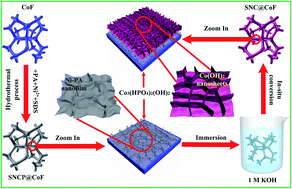In situ conversion of sub-4 nm Co(OH)2 nanosheet arrays from phytic acid-derived Co3(HPO4)2(OH)2 for superior high loading supercapacitors†
Abstract
Co(OH)2 is a candidate cathode material for supercapacitors due to its essential features of high theoretical capacity and long cycle life. Herein, by using phytic acid (PA) as an intermediate connector between Co foam substrates and Ni2+ ions, a Ni-PA nanofilm-covered Co3(HPO4)2(OH)2 precursor was grown in situ on Co foam in the presence of sodium dodecyl sulfonate (SDS). A 3D nanoarchitecture of ultrathin Co(OH)2 nanosheet arrays was built through the spontaneous in situ conversion of a Co3(HPO4)2(OH)2 precursor immersed in an alkaline solution. Even with a high loading of 12 mg cm−2, the as-prepared SDS-modified Ni-PA/Co(OH)2@CoF (SNC@CoF) electrodes exhibited a high specific capacitance (Qm) of 429 mA h g−1 (0.42 A g−1) and excellent cyclability with 124.3% retention after 20 000 cycles. Furthermore, an asymmetric supercapacitor (ASC) using the modified material can deliver a large energy density of 51.3 W h kg−1 and an outstanding cycle life (96% retention after 20 000 cycles).



 Please wait while we load your content...
Please wait while we load your content...